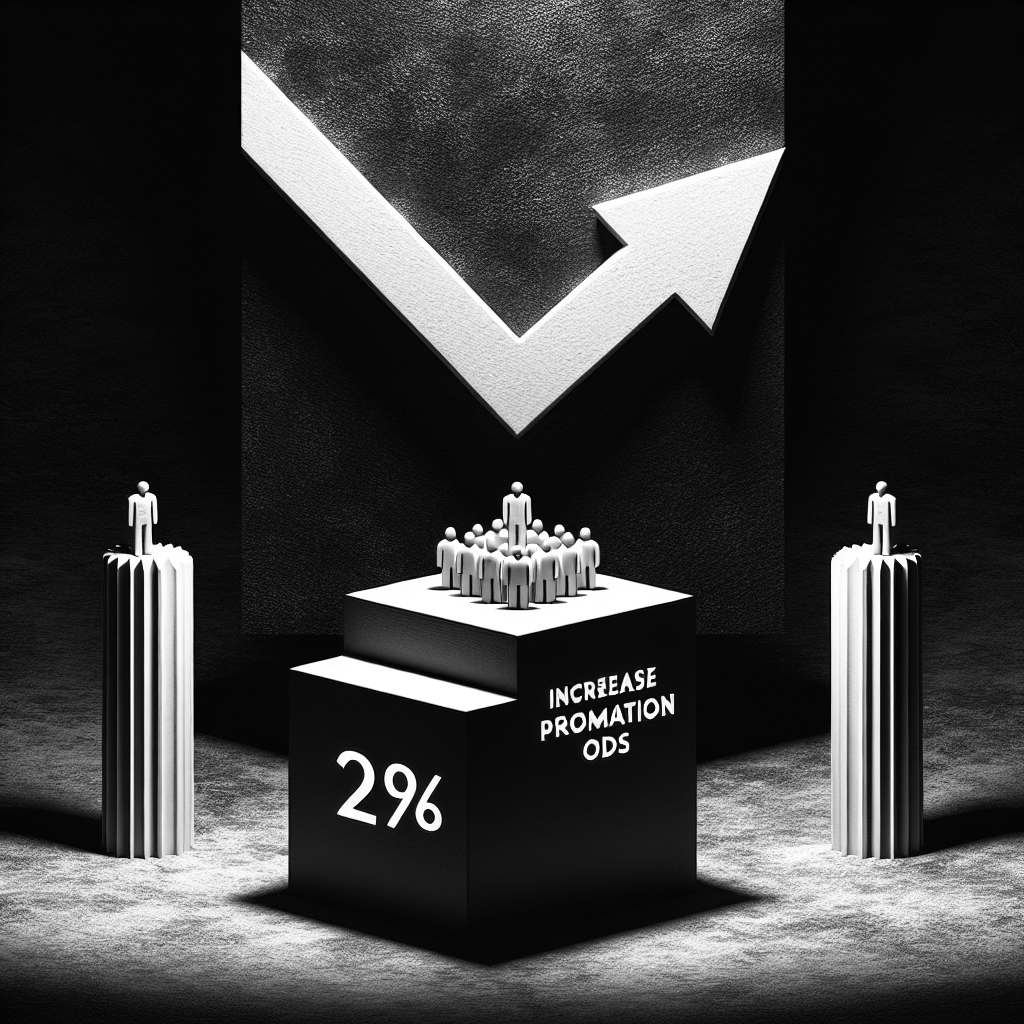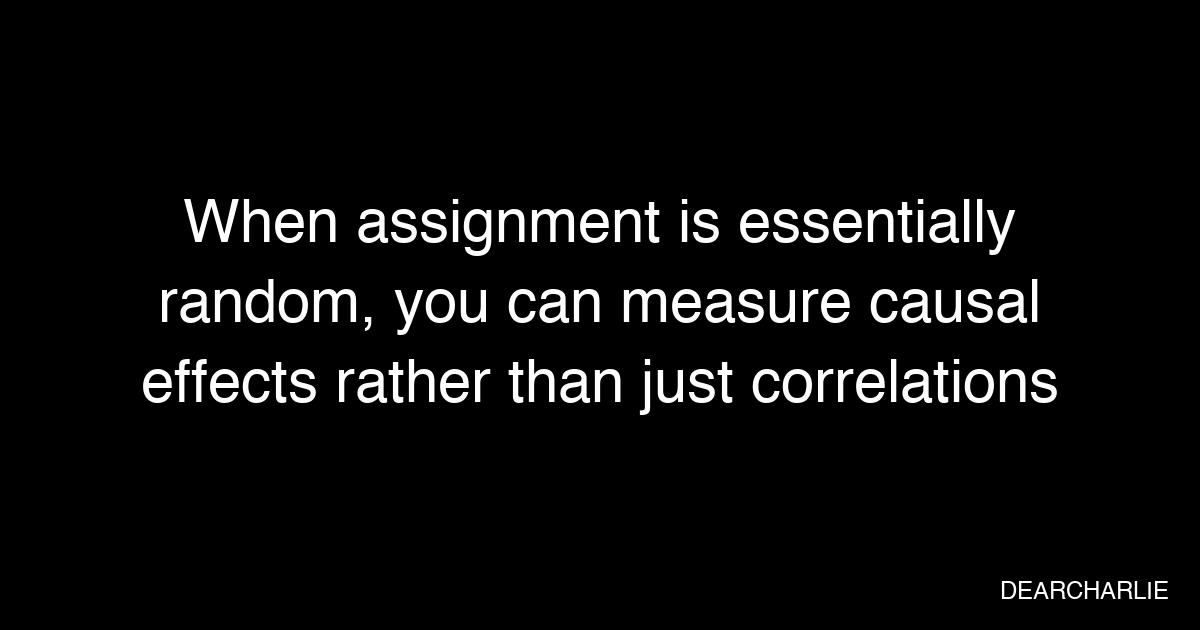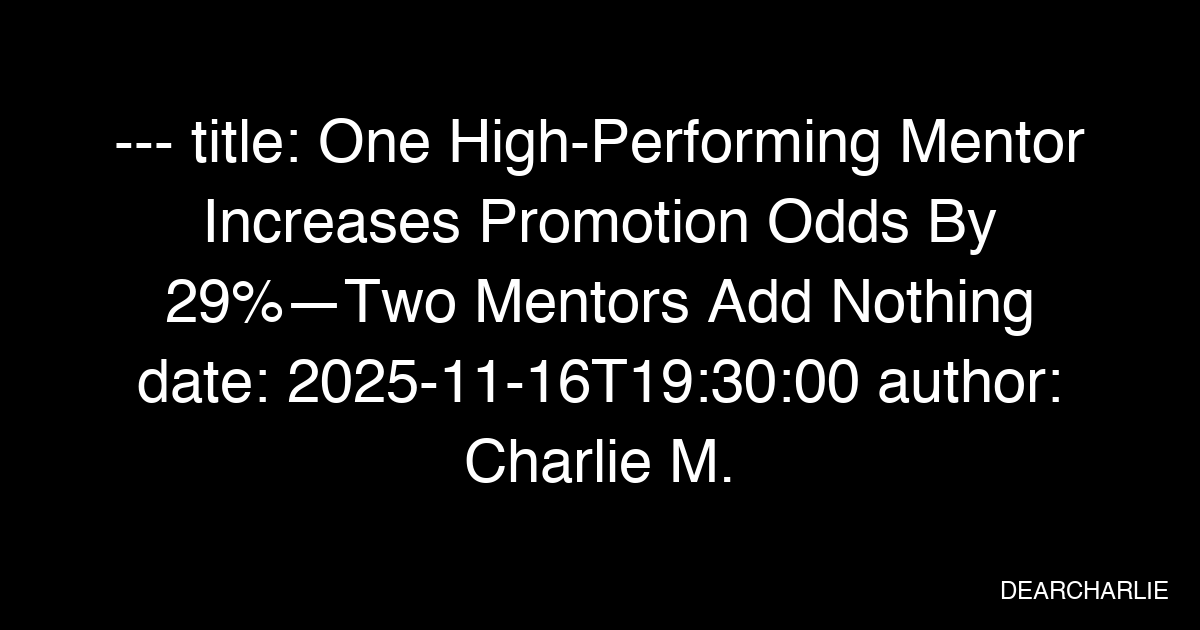David Lyle and John Smith published research in the Journal of Labor Economics in 2014 that answers a question most mentorship studies can't touch: do mentors actually cause better career outcomes, or do successful people just attract better mentors?

The U.S. Army accidentally designed the perfect experiment to find out.
Company commanders get assigned to battalion commanders based purely on the needs of the Army.
A captain graduating from the Career Course in June gets assigned to whichever battalion has an open slot.
The characteristics of the captain and the battalion commander don't guide the assignment.
The Army needs bodies in positions and moves officers accordingly.
This creates something economists call a natural experiment.
When assignment is essentially random, you can measure causal effects rather than just correlations.
Lyle and Smith used Army administrative data covering thousands of company commanders and their battalion commander mentors between 1991 and 2006.
They tracked who got promoted early to Major and worked backward to see if the quality of their mentor mattered.
It did.
Company commanders who served under a high-performing mentor—defined as a battalion commander who himself was promoted early—were 29% more likely to receive early promotion to Major.
Not 29 percentage points.
Twenty-nine percent increase in probability.
If the baseline early promotion rate was 20%, serving under a high performer pushed it to about 25.8%.
The effect compounds with duration.
Mentorships in the Army typically last 18 months.
Officers who served the full period showed stronger effects than those rotated out early.
Every additional month under a high-performing mentor increased early promotion probability.
The relationship was roughly linear up to the typical 18-month assignment length.
The heterogeneous treatment effects show up most clearly when splitting by protégé ability.

High-ability company commanders—measured by pre-treatment indicators like West Point graduation, prior evaluations, and early Career Course completion—gained the most from high-performing mentors.
Lower-ability officers showed smaller effects or none at all.
This pattern suggests complementarity.
Mentor quality and protégé ability interact multiplicatively rather than additively.
A high-performing mentor paired with a high-ability protégé produces outcomes neither could achieve alone.
The same mentor paired with a lower-ability protégé produces marginal gains.
This isn't surprising theoretically, but measuring it in a causal framework is rare.
The most counterintuitive finding was about multiple mentors.
Lyle and Smith tracked officers who served under two or more high-performing battalion commanders during their company command years.
The second high-performing mentor added nothing.
Zero marginal benefit.
An officer who served under one high performer and one average performer had the same promotion probability as an officer who served under two high performers.
This breaks the naive model of mentorship where more exposure to excellence compounds returns.
If mentorship primarily transferred skills or knowledge—what economists call human capital accumulation—you'd expect diminishing but positive returns from additional mentors.
Each mentor would teach something new, and while the second might add less than the first, they'd still add something.
The zero marginal return suggests a different mechanism.
One possibility is signaling.
A high-performing battalion commander writes better evaluation reports for their company commanders.
Promotion boards read those evaluations.
The evaluation from one high performer signals quality.

The evaluation from a second high performer doesn't add new information—the board already updated their beliefs after the first signal.
Another possibility is network effects.
A high-performing battalion commander has connections to senior officers on promotion boards or in key assignment positions.
Those connections help a protégé once.
Additional connections from a second mentor don't help if the first mentor's network already opened the necessary doors.
The Army promotion system complicates interpretation.
Officers don't get promoted based purely on evaluations.
The system uses time-in-grade requirements, mandatory training completions, and centralized boards.
Early promotion to Major requires exceptional performance, but exceptional performance alone isn't sufficient.
You also need the right timing, the right assignments, and board composition that values your particular strengths.
Lyle and Smith controlled for observable characteristics—prior performance, education, training timing—but unobservable factors remain.
Maybe high-performing battalion commanders get assigned the most critical units, and commanding a critical unit independently increases promotion probability.
The random assignment mitigates this concern but doesn't eliminate it entirely.
The duration effects provide additional evidence.
If the entire effect came from being assigned to a critical unit, duration wouldn't matter—you'd get the benefit from the assignment itself.
But promotion probability increased with months served under the high-performing mentor, which suggests something about the mentorship relationship itself mattered.
The practical implication cuts against conventional mentorship advice.
Corporate mentorship programs typically encourage junior employees to seek multiple mentors with different expertise.
The Army data suggests one high-quality mentor produces most of the achievable gains.
Additional mentors might provide value through knowledge diversity or different perspectives, but they don't improve promotion outcomes.

The study measured promotion to Major, which happens 10-13 years into an Army career.
Officers serve as company commanders years 6-8, then compete for Major around year 10.
The promotion boards evaluating them have access to evaluations written by battalion commanders from 2-4 years earlier.
The mentorship effect persists across that time gap.
Lyle and Smith couldn't directly measure what high-performing mentors do differently.
They observed inputs (mentor quality) and outputs (protégé promotion) but not the mechanism.
High performers might provide better feedback, make better tactical decisions that create learning opportunities, write more detailed evaluations, or introduce protégés to senior officers.
The data shows the effect exists without explaining how it operates.
The 29% figure represents an average treatment effect across all company commanders.
Individual experiences vary widely.
Some officers serving under high performers received no promotion benefit.
Others saw larger gains.
The aggregate effect of 29% emerged from thousands of mentor-protégé pairs over 15 years of data.
The Army context might not generalize to civilian organizations.
Army mentorships involve daily interaction over 18 months between officers of adjacent ranks working in the same unit.
Corporate mentorships often involve monthly meetings between executives and junior employees in different departments.
The intensity and proximity differ substantially.
But the causal identification strategy does generalize.
Any organization with quasi-random assignment of supervisors and objective outcome measures could replicate this analysis.
Most organizations lack both conditions.

Employees select into teams, managers select their reports, and outcomes get measured subjectively.
The zero marginal return from additional mentors remains the sharpest insight.
It suggests mentorship effects don't accumulate linearly.
One high-quality relationship produces most of the measurable career benefit.
More relationships might produce learning, satisfaction, or other hard-to-measure outcomes, but they don't increase promotion probability further.
The complementarity between mentor quality and protégé ability creates an equity concern.
High-ability officers gain the most from high-performing mentors.
Lower-ability officers gain less or nothing.
If mentor assignment were truly random, this would average out over many assignments.
But if any non-random sorting occurs—even slight sorting based on unobservable factors—it could compound inequality rather than reduce it.
Lyle and Smith's work demonstrates what rigorous causal inference reveals that correlational studies miss.
Observational studies of mentorship consistently show that people with mentors earn more and get promoted faster.
But those studies can't distinguish whether mentors cause success or successful people attract mentors.
The Army's quasi-random assignment solves that problem and produces a clean estimate: 29% higher probability of early promotion, zero marginal benefit from additional mentors, largest effects for high-ability protégés.
The findings appeared in the Journal of Labor Economics in April 2014.
The paper used administrative data from 1991 to 2006, covering multiple cohorts of company commanders across different eras of Army operations.
The consistency of the 29% effect across those different periods strengthens confidence in the result.
One high-performing mentor, serving for the typical 18-month period, produces a measurable and substantial career benefit.
A second high-performing mentor produces nothing additional.
The difference between zero and one is 29%.
The difference between one and two is zero.